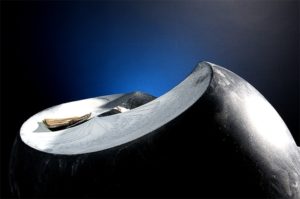Creativity:
The Case of Michael Ondaatje
All my life I’ve
wondered where ideas come
from. The rich literature on creativity
gives no hint of how to make ideas happen.
As much as we may prefer to think there is,
there may be no such thing as
methods of creation.
An equally rich literature
suggests many ways to stimulate
creative thought, and that’s
a different thing.
We all have creative
bones in our bodies, and we were
born that way. Our challenge is not to make
ideas happen, but to allow imagination to unfold
and creative juices to flow into the unknown.
By definition, that is where all new
ideas are found.
From what I’ve
read, and from the creative
disciplines of science, education,
and art, stimulating creative
thought is a very different
thing than making
ideas happen.
A few minutes
ago, polishing a concave face
of Heart of Anima by hand and feeling
its form, I remembered a story Michael
Ondaatje tell about himself. It says lots
about stimulating creative thought
and nothing about where
ideas come from.
The night I arrived
in Singapore on a 3 month educational
consulting gig the National University in 1997,
I attended a talk by Michael Ondaatje about his own
writing process. His talk came with a screening of
The English Patient, based on his novel
by the same name.
Much more than
being an introduction to the film,
his talk provided a clear window into his
creative process. His stories offered nothing about
where his ideas come from, but showed how his
method of writing stimulates his
imagination.
Most interesting to
me was his confession that he doesn’t
know what he’s doing when he writes. He
just starts telling stories without knowing
where they will go, then keeps on telling
them until they are done.
For Ondaatje,
stories and books
are different.
Once he finishes
a story, he rewrites, rewrites,
and rewrites rewrites again until the
book is done. One way of saying it
is that after he writes the story, he
has to write the book so we
can “get” the story.
That doesn’t
sound like much of a method.
But it works for Michael Ondaatje, at
the cost of years of effort in telling
the story and writing the book.
He wrote a wonderful
book about editing of both literature and film:
The conversations: Walter Murch
and the art of editing film.
According to
Ondaatje, he has a horrible
habit of starting stories he doesn’t
know how to finish. He starts a story, then,
before he knows it, he’s written himself
into a situation he doesn’t know
how to get out of.
That is
what happened with The
English Patient. He spent about six years
writing his way out of a predicament he’d made
for himself near the beginning. The complex story
line, especially its jumping back and forth in time,
indicates some of the contortions he had
to perform to make it work.
From my
perspective, The English
Patient was a great example for him
to use in that talk. But he claimed
it always works that way
for him.
Based on
my own experience of doing
things, I believe him. That’s how it works
for me too, regardless of whether I like it. In
sculpting, writing, science, cooking, and many
other activities that make a difference. I
suspect that’s the way it is when
we push our limits.
What is Ondaatje’s method
of creation in writing?
According to
what I took from the stories
he told in Singapore, his method is
simply to go into his studio and make stuff,
keeping his wits about him and using his noggin
to get himself out of messes he makes.
As I
suggest in several of
my own stories, something like
this may be the best we can hope for,
in any creative endeavour.

Note that
Gerhard Herzberg claims
that if you know what you’re doing
you aren’t doing science. That theme
pervades many stories on this site.
First published in the Vancouver Observer.
Edited June 2021.





